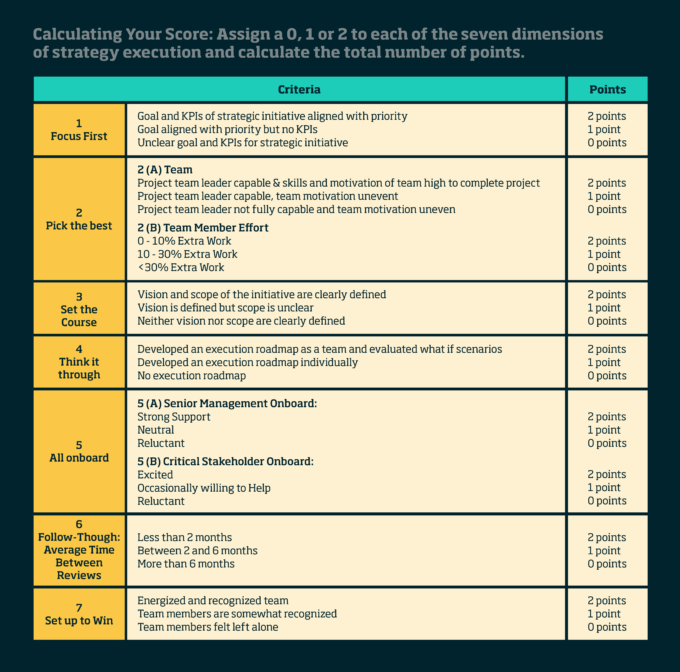
Why it’s vital to gear up for the ‘globotics’ revolution
The forces of globalization and robotics – ‘globotics’ – are opening a new pathway to prosperity for developing nations. Richard Baldwin shares his vision of how this could look....

by Bettina Büchel Published 25 July 2023 in Strategy • 6 min read
Not so long ago, I was invited to speak at the strategy conference of a listed European company on the topic of strategy execution. The well-choreographed corporate event started with the CEO outlining the strategy for the next five years. Armed with PowerPoint slides, he outlined the expected growth strategy of 20% and an expected return on equity of 15%. At the end of his speech, he reflected on the last strategic period and concluded that there had been too many strategic priorities, that there were too many internal conflicts and little alignment among the business units and functions, and that setting targets was simply not enough to ensure successful execution of the strategic initiatives that emerged from the firm’s priorities.
So how can you assess if you are on track in implementing your strategic initiatives? Strategic initiatives are a burst of focused energy to address issues that are critical for the execution of the strategy. They represent efforts above and beyond everyday operating excellence and are meant to change the way in which the business is run. As a result, they are expected to have a cross-organizational impact. This is what makes their execution often a challenge. To assess whether you are on track, I have developed the Smarter Execution Score, which allows you to evaluate an initiative’s status to inform your analysis of its progress and whether to make any changes. Evaluate yourself on the following seven dimensions of strategy execution (Smarter Execution, 2008):
1. Focus first – maintaining a sense of direction and of priorities in a dynamic context by selecting ambitious and achievable initiatives
2. Pick the best – assigning the best possible people to the initiative
3. Set the course – setting an ambitious and achievable goal and a scope for implementation
4. Think it through – mentally rehearsing the details and sequence of execution at a high level to develop a roadmap
5. All onboard – gaining commitment from stakeholders and maintaining a high level of synchronization across units
6. Follow through – keeping up with progress in a way that produces the required deliverables and learning for the steps forward
7. Set-up to win – sustaining a high level of energy within the team and throughout the wider organization

When embarking on a strategic initiative, one factor of success is to have a clear focus with goals and key performance indicators aligned with the strategic priorities. If the goals and KPIs are not aligned, it can lead to confusion and derailment.
Another key consideration is people and, more specifically, the team. It is important to have a capable and well-connected team leader who can motivate team members. If the team leader is not highly motivated and team motivation is uneven then the initiative often suffers. In addition, the amount of effort the team has to invest needs to be considered. The initiative should not put undue pressure on team members. If team members need to put more than 30% extra effort on top of the “normal” job, it can lead to burnout and negatively impact the initiative’s outcomes.
Having a clearly defined initiative vision and scope will help the team to stay focused and motivated. If the vision is defined but the scope is unclear, then the initiative is at risk. If, however, neither the vision nor the scope is clearly defined, then the initiative is at a high risk of failure.
Developing an execution roadmap as a team and evaluating “what if” scenarios are additional factors for success. If the team develops an execution roadmap, evaluates alternative pathways to achieve the vision, and is thereby prepared for eventualities, then the initiative is on track. If neither a roadmap exists nor has the team spent the time to evaluate potential stumbling blocks, the initiative is left with a goal but no path to get there.
Stakeholder support is also crucial. Senior management should provide strong support and critical stakeholders should be excited and willing to help. If senior management is neutral and critical stakeholders are reluctant helpers, then the initiative is at risk. If neither senior management nor stakeholders are supportive, there is a high risk of failure.
By integrating the Smarter Execution Score into your reviews, you too can pinpoint areas where your organization could improve the delivery of its strategic initiatives and then make the necessary adjustments to get back on track.
The sixth factor is follow-through. It is essential to keep track of the initiative, and this often occurs through reviews. If too much time elapses between reviews, the initiative is at higher risk as little attention is given to discussing issues at hand. It can also indicate a lack of interest in solving problems.
Finally, maintaining execution energy throughout implementation is key. The team needs to be recognized and supported, and team members should not be left alone. The lower the energy within a team, the higher the likelihood that motivation levels will suffer, and momentum will be lost.
By focusing on these seven execution areas, you’ll be well on your way to a successful strategic initiative. And, by using the scoring system to evaluate your progress along the way, you’ll be able to course correct as needed.
Calculate your score using the following formula: Focus first + Pick the best (A) + Pick the best (B) + Set the Course + Think it through + All onboard (A) + All onboard (B) + 2 x Follow-through + Set up to win.
This will give you a score between 0 and 20, giving you an indication as to whether your initiative is in one of three zones: Distress, Doubt or Deal. If you are in the Distress zone, you need to radically re-evaluate your efforts to boost the initiative. If you are in the Doubt zone, you need to make some adjustments as there is likely insufficient progress being made and you are falling short on some dimensions of execution. If you are in the “Deal” zone, you can continue as is.

Oftentimes, leaders can spend two days reviewing strategic progress with wide disagreements among senior management, sponsors, and key initiative leaders. Using the Smarter Execution Score, the discussion can become more focused on what needs to change to make progress. Some companies use this framework to assess not just individual initiatives, but transformation programs with a portfolio of initiatives. This can serve as an early warning system as to whether execution of the strategy is on track. This tends to mean reconfiguring the team, assigning extra resources, providing more time for reviews, or actively resolving conflicts that emerge. This is exactly how one firm, a Danish coatings company, realigned senior management on the extra effort they needed to make in terms of management time, resources, and commitment for its own strategic initiatives.
By integrating the Smarter Execution Score into your reviews, you too can pinpoint areas where your organization could improve the delivery of its strategic initiatives and then make the necessary adjustments to get back on track.

Professor of Strategy and Organization at IMD
Bettina Büchel has been Professor of Strategy and Organization at IMD since 2000. Her research topics include strategy implementation, new business development, strategic alliances, and change management. She is Program Director of the Strategy Execution and Change Management open programs, as well as teaching on the flagship Orchestrating Winning Performance (OWP) program.

24 October 2023 • by Richard Baldwin in Competitiveness
The forces of globalization and robotics – ‘globotics’ – are opening a new pathway to prosperity for developing nations. Richard Baldwin shares his vision of how this could look....

20 October 2023 • by David Bach in Competitiveness
Amid a complex situation rife with uncertainties, businesses should be prioritizing political risk alongside economic opportunities....

6 October 2023 • by Howard H. Yu in Competitiveness
Unpredictability in the marketplace can quickly burst the bubble of any company not agile enough to adapt to change.Here are lessons from the soda pop giant’s successful mission to update and diversify...

20 September 2023 • by Arturo Bris, Misiek Piskorski in Competitiveness
South Korea’s global champions and its broader economic landscape offer invaluable lessons for leaders worldwide. ...
Explore first person business intelligence from top minds curated for a global executive audience